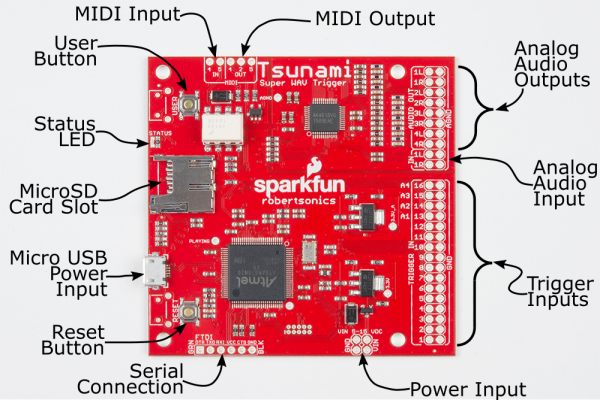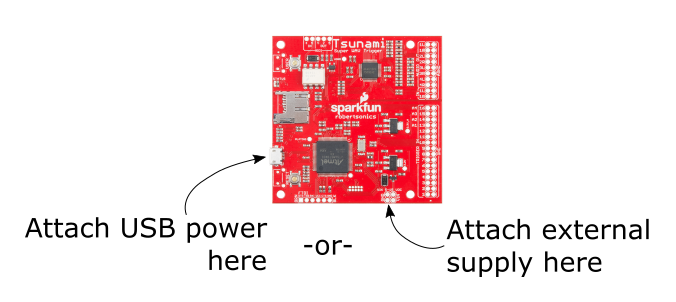Tsunami Hookup Guide
Hardware Overview
The Tsunami board has the following features and interfaces.
- MicroSD card slot. We've had the best results with Class 4 and Class 10 cards.
- Micro-B USB port for power input.
- Reset switch. Used to reinitialize Tsunami, particularly after swapping the SD card.
- 3.3V FTDI-style serial interface. Tsunami can be controlled using a PC, or an external microcontroller.
- Atmel ATSAMS70N20 Cortex M7 microcontroller. The brains of the whole operation!
- 0.1 inch header power input. Connect an external supply of 5--15 VDC here.
- 16 trigger inputs. Used to control WAV file playback. Each has an adjacent ground pad to make connecting switches easier.
- Stereo audio input. Can be mixed to any combination of outputs.
- Audio outputs, configurable as four stereo outputs or eight mono outputs. Again, each output has an adjacent ground pad to facilitate wiring.
- MIDI input and output ports. Just add 5-pin DIN connectors for MIDI.
Each of these is described in more detail in the Tsunami Online User Guide.
Tsunami Power Notes
Power Supply Requirements
Tsunami should be powered with between 5 and 15 VDC. Tsunami is also rather power hungry: While playing WAV files, it draws about 200 mA.
Power can be applied two ways. For convenience, Tsunami can be powered by the USB micro-B connector, from a USB port, or a micro-B terminated wall adapter. Alternatively, Tsunami can be powered more directly using the 0.1 inch header power input.
Logic Levels
On Tsunami, the incoming voltage is regulated down to 3.3V for all of the onboard circuitry. The processor, codec and other circuitry are all powered from 3.3V.
Tsunami's digital interfaces operate at 3.3V and are not compatible with 5V logic. If you are connecting other devices to the FTDI header or trigger inputs, you need to be sure to use 3.3V devices, or a voltage translator to bridge the gap.
The one exception to this is the opto-isolated MIDI input. Being opto-isolated, it is fully compatible with regular 5V MIDI circuitry.

